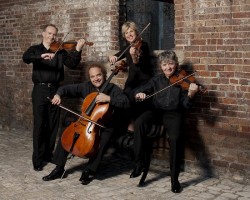Standing Out in a Crowd
 We live in a golden age of chamber music ensembles, not only string quartets, but established piano trios and piano quartets, which would have been unheard of half a century ago. The bar is high. No one gets away with vague intonation or rhythm any more. Ensemble means just that; a group must sound like a single instrument.
We live in a golden age of chamber music ensembles, not only string quartets, but established piano trios and piano quartets, which would have been unheard of half a century ago. The bar is high. No one gets away with vague intonation or rhythm any more. Ensemble means just that; a group must sound like a single instrument.
In a crowded field, the Takacs Quartet stands out. Of the many fine string quartets currently active, perhaps only the Emerson String Quartet is their equal. Founded in Budapest in 1975, the quartet still contains two of its original members, second violinist Karoly Schrantz, and cellist Andras Fejer (bottom right and left in the photo). They moved to America to become quartet-in-residence at the University of Colorado at Boulder in 1983. In 1993, British violinist Edward Dusinberre became first violinist, and in 2005 American violist Geraldine Walther joined the group.
My wife and I saw the Takacs Quartet at their last appearance in the Shriver Hall Concert Series of Johns Hopkins University in 2005, and I was eager to hear their return performance this past Sunday evening. Their program was ambitious, combining three great string quartets that, while diverse in style, were all quite heavy and demanding on listeners as well as players. Claude Debussy’s only string quartet and first masterpiece, Czech composer Leos Janacek’s spiky String Quartet No. 1 “Kreutzer Sonata”, and Beethoven’s visionary late quartet, String Quartet No. 14 in C-sharp minor, Op. 131. The closest thing to a “light” work on this program was the Debussy, which itself is harmonically experimental and light only in its subtlety.
I am familiar with all three works but to different degrees. The Janacek I enjoy but have heard less frequently than some other works by that composer, the Debussy has been a favorite for decades, and the Beethoven I have truly loved since my college days, listening to it in hushed reverence.
Debussy begins with a motto theme not unlike Beethoven, and like Beethoven in the Fifth Symphony he repeats it throughout the work. Harmonically, however, Debussy is in a different universe. I have heard performances in which the opening statement of that motto was more assertive and startling. The Takacs opted for a gentler introduction, but very soon the range of textural, tonal, and rhythmic expressivity established itself and did not diminish. A high note by the first violinist in the slow movement was impossibly sweet, all the more so for its understatement.
In fact, I found myself marveling over the individuality of each musician, infusing phrases with such personal inflections that I was always aware that I was hearing four separate performers. And yet, against all odds, the group’s seamless technique never faltered, turning these four individuals into “one voice”, a near perfect blend of personal expressivity and balance. One player’s nuance would be picked up and reflected by another, a nuance would be shared by all four, or pairs and trios would contrast with another.
The Janacek quartet is based on Tolstoy’s story of a wife with a jealous husband who finally murders her. The work brought the most furious playing from the ensemble, again with individual intensity and superb technique. It even received a pleasingly whimsical spoken introduction by first violinist Edward Dusinberre, who commented that the catalyst for the husband’s jealousy in the Tolstoy story is a violinist who is “a rather slimy man, if one can imagine a violinist like that.”
As for the Beethoven, along with the “Heiliger Dankesang” (Holy Song of Thanks) from the String Quartet No. 15 in A minor, Op. 132, the String Quartet No. 14 may be the greatest music Beethoven ever composed. The work is in seven movements, but two of those movements are barely more than a minute long, so they feel more like introductions to the following movements. The Takacs wisely performed all seven movements without pause. As in Beethoven’s last piano sonatas, the quartet contains a theme and variations movement that by the end has ascended beyond the realm of the living. Quite literally, Beethoven contrasts the high and the low, with emptiness between them. The two violins play a simple, hymn-like variation in harmonized high notes with a repetitious rhythm, while the cello answers them, as if earth-bound, with a low, growling motif. This sublime passage has never sounded more human to me than in the Takacs Quartet’s rendition, as if Beethoven were mocking the cosmos.
photo by Ellen Appel
Tags:Shriver Hall Concert Series, Takacs Quartet




